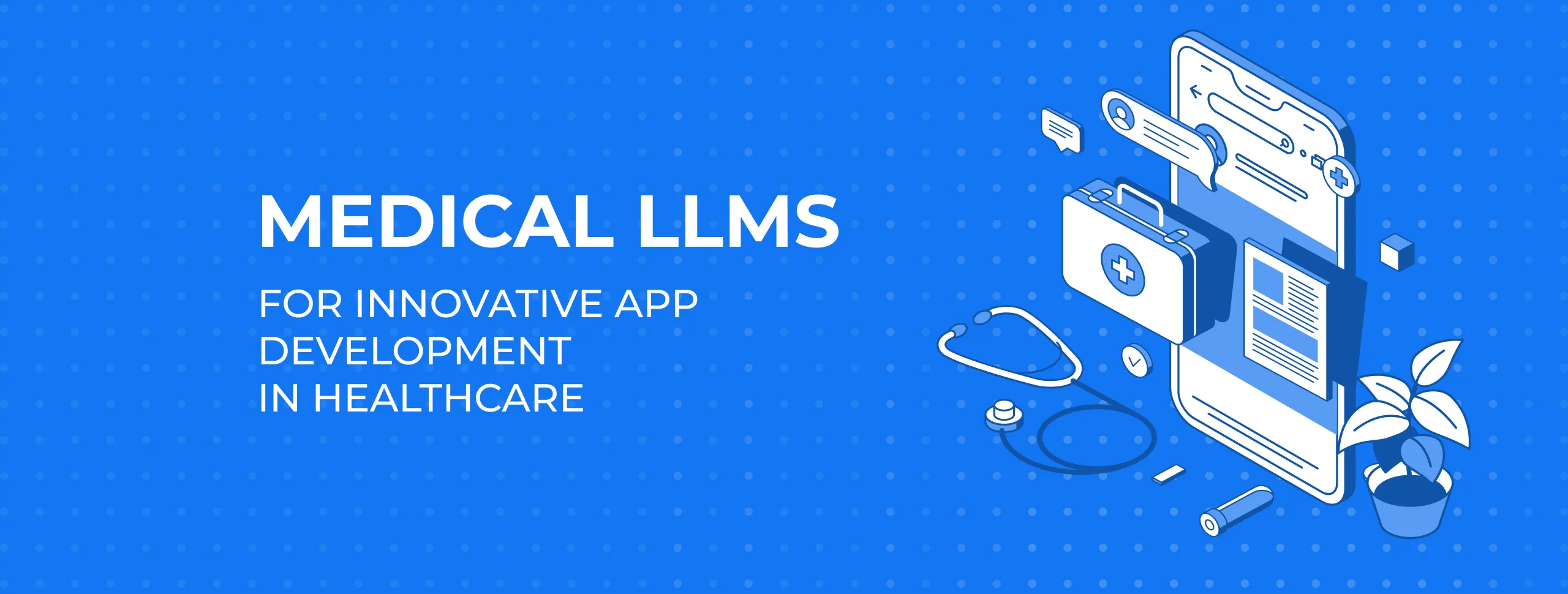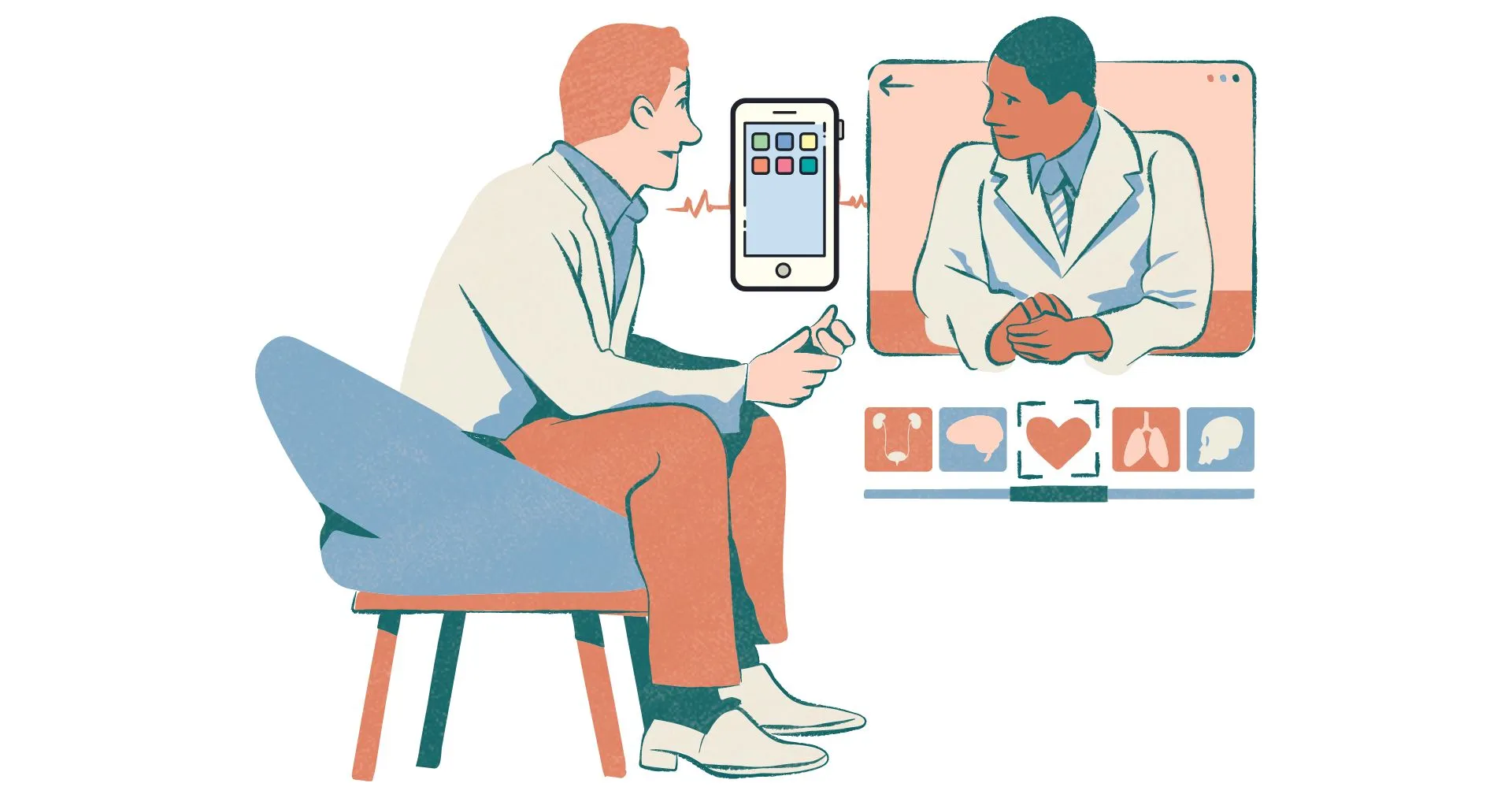
Medical Large Language Models for App Development

Table of contents
- An Overview of Existing Large Language Models in Healthcare
- How LLMs Can Be Integrated into Web and Mobile Apps
- The Role of Retrieval-Augmented Generation (RAG) in Enhancing LLM Capabilities
- Conclusion
The emergence of AI chatbot development has drawn significant attention due to their incredible language understanding and content creation abilities. This showcases the great potential of large language models (LLMs). LLMs are advanced AI systems trained on vast amounts of text data. This enables them to understand and generate human-like language. Various sectors have begun to realise the power of LLMs to boost their operations.
In the healthcare sector, specifically, LLMs are being increasingly adopted to enhance different aspects of medical practice and administration. These models can analyse extensive medical data, assist in diagnosing diseases, recommend treatments, and even predict patient outcomes.
This article explores how LLMs are used in innovative app development and implementation within the healthcare field.

An Overview of Existing Large Language Models in Healthcare
Healthcare is one of the most promising fields for the application of Large Language Models (LLMs), showcasing the transformative potential of AI in healthcare. These advanced AI models are changing how medical professionals diagnose, treat, and interact with patients, leading to significant improvements in patient care and operational efficiency.
Here are some of the most of the most advanced LLMs in healthcare:
Med-PaLM (Google)
Developed by Google, Med-PaLM large language model offers specialised assistance in healthcare by providing accurate and relevant answers to complex medical queries.
Med Gemini
Another initiative by Google, Med Gemini uses advanced AI-driven solutions to improve various aspects of medical practice, from diagnostics to patient care.
Med-BERT
A variant of the BERT model, Med-BERT is fine-tuned for medical applications. It plays a key role in understanding medical texts and enhancing patient care by facilitating better information retrieval.
BastionGPT
BastionGPT is a tailored version of GPT-3. This model enhances clinical decision-making and patient interactions through its advanced natural language processing capabilities.
MedGPT
MedGPT is another specialised version of GPT. It is fine-tuned on medical data to support patient interaction and clinical decision support.
MedAlpaca
MedAlpaca expands upon both Stanford Alpaca and AlpacaLoRA to offer an advanced suite of large language models specifically fine-tuned for medical question-answering and dialogue applications.
OpenEvidence
The leading AI-powered medical information platform to aggregate, synthesize, and visualize clinically relevant evidence in understandable, accessible formats that can be used to make more evidenced-based decisions and improve patient outcomes.
Want to understand LLMs better? Check out our guide to using LLMs for business.
How LLMs Can Be Integrated into Web and Mobile Apps
More than just advanced algorithms, medical LLMs represent a transformative approach to healthcare innovation, showcasing the benefits of AI in healthcare. They can easily integrate with existing systems, where they can be used to provide deep insights through data analysis. As a result, there is more effective and accurate communication between patients and healthcare providers.
Here’s a detailed look at how LLMs can be utilised in various healthcare web and mobile app development solutions:

1. Personalized Health Monitoring
LLMs help in creating apps that provide personalised health insights by:
-
Analysing Data: LLMs interpret data from wearables and health trackers to offer tailored recommendations. They can identify patterns in the data to provide personalised health advice.
-
Generating Reports: These models produce personalised health reports based on user data and historical trends. These reports can highlight key health metrics.
-
Predicting Health Issues: LLMs can identify potential health issues early based on user inputs and patterns. This enables preventive measures, as well as timely interventions.
2. Clinical Documentation Automation
LLMs can improve the way clinical documentation is handled by automating various aspects of the documentation process:
-
Transcribing: These models can convert spoken patient interactions into accurate written records. This reduces the time healthcare providers spend on manual data entry. It also improves the accuracy of patient records.
-
Summarising: LLMs can condense lengthy patient notes and interactions into concise summaries, making it easier for healthcare providers to understand patient information quickly.
-
Categorising: LLMs can organise information into relevant categories, such as symptoms, diagnoses, and treatment plans. This structured approach helps in efficiently managing patient data.
3. Symptom Checker and Triage
A 2023 research paper in BMJ Health & Care Informatics showed that AI-powered symptom checkers had an accuracy rate of 70-80% for initial diagnoses, depending on the condition.
LLMs enhance symptom checkers by:
-
Assessing Symptoms: LLMs analyse user-reported symptoms to provide initial diagnostic suggestions. This helps users understand their health conditions better.
-
Guiding Actions: These models advise users on whether to seek medical attention or manage symptoms at home. This approach improves patient outcomes and reduces unnecessary medical visits.
-
Learning from Interactions: LLMs ensure better accuracy over time through new medical information, making the symptom checkers more reliable.
4. Drug Interaction and Safety Monitoring
Cutting edge large language models can be used to:
-
Identify Interactions: These models analyse user medication data to check for potential drug interactions. This ensures patient safety.
-
Warn Users: LLMs provide alerts about possible side effects or unsafe combinations of medications. This helps users avoid adverse reactions.
-
Update Knowledge: LLMs incorporate the latest research and drug information into safety checks, keeping the system up-to-date with current medical knowledge. They are also instrumental in software solutions for clinical trials, ensuring that trial data and protocols are current and accurate.
5. Virtual Health Assistants
A 2023 study published in JAMA Network Open found that AI tools, including natural language processing models, could reduce time spent on administrative tasks by 30% in healthcare settings.
LLMs power virtual assistants by:
-
Providing Information: These models answer health-related questions and provide general medical information with an ethical approach. This assists users in understanding their health conditions.
-
Offering Support: LLMs help with medication reminders, appointment scheduling, and follow-up care, improving patient adherence.
-
Engaging Users: LLMs offer interactive conversations and personalised health advice, enhancing user experience. They can also be utilised in virtual wards to provide continuous patient support and monitoring. Check out this article on how the idea of virtual wards is gaining traction.
6. Chronic Disease Management
For chronic conditions, LLMs can:
-
Monitor Progress: LLMs track and analyse data from users to assess disease management and adjust recommendations, ensuring continuous and personalised care.
-
Provide Tips: These models LLMs offer personalised advice on lifestyle changes and adherence to treatment plans, helping patients manage their conditions effectively.
-
Support Decision Making: LLMs help users and healthcare providers make informed decisions about disease management. LLMs can be integrated into Software as a Medical Device (SaMD) to enhance their functionality and provide real-time insights. Read more in this article about SaMD and the integration of LLMs.
7. Medical Education and Training
LLMs contribute to education by:
-
Creating Content: These models generate educational materials, including case studies and quizzes for medical students and professionals, enhancing learning resources. Read more about the latest trends in educational technology in this article about EdTech 2024.
-
Simulating Scenarios: LLMs provide interactive simulations and training scenarios based on clinical data.
-
Updating Knowledge: LLMs deliver the latest research findings and medical advancements to learners, keeping them informed about current trends.
8. Mental Health Support
LLMs in mental health apps can:
-
Offer Therapy: LLMs provide therapeutic support through chatbots and virtual counsellors, offering accessible mental health care.
-
Track Mood: These models monitor and analyse mood patterns to offer personalised coping strategies.
-
Deliver Resources: LLMs suggest resources and exercises for managing stress, anxiety, and other mental health issues.
9. Telemedicine Integration
LLMs enhance telemedicine by:
-
Facilitating Communication: LLMs assist in real-time communication between patients and healthcare providers. Explore how Large Language Models are revolutionising telemedicine and saving lives in our latest article: Modern Trends in Telemedicine.
-
Analysing Data: LLMs provide insights and recommendations based on patient data shared during virtual consultations. This improves the quality of remote care.
-
Improving Accuracy: These models support providers with data-driven insights to ensure effective and accurate diagnoses and treatment plans.
10. Health Data Integration and Insights
In integrating health data, LLMs can:
-
Synthesise Information: LLMs combine data from various sources, such as EHRs, patient inputs, and medical devices to create a comprehensive health profile. Some of these devices include heart rate monitors, glucose metres, and wearable fitness trackers that provide a holistic view of a patient's health. Read more about the integration of medical devices and remote healthcare systems in this article.
-
Generate Insights: These models analyse integrated data to provide actionable insights and identify trends, supporting proactive health management.
-
Support Decision Making: LLMs offer data-driven recommendations to improve care coordination and patient outcomes, enhancing healthcare delivery.
11. Patient Education Materials
LLMs can help create educational materials by:
-
Customising Content: These models tailor information to the patient’s specific condition and comprehension level, ensuring effective communication.
-
Explaining Conditions: LLMs provide clear and understandable explanations of medical terms, diagnoses, and treatments, empowering patients with knowledge about their health.
-
Generating Resources: LLMs create brochures, videos, and interactive content for better patient education, enhancing patient engagement.
Find out more about the ethical considerations of using AI in education and healthcare in this article.
12. Predictive Analytics for Disease Outbreaks
A 2024 study in The Lancet reported that AI-driven predictive models could forecast disease outbreaks with up to 80% accuracy, providing early warnings.
LLMs can aid in predicting disease outbreaks by:
-
Analysing Trends: LLMs examine large datasets to identify patterns and early signs of potential outbreaks. This enables timely interventions.
-
Generating Alerts: These models provide early warnings and recommendations for public health preparedness. This supports effective response strategies.
-
Supporting Research: LLMs assist researchers in understanding the spread and impact of diseases. As a result, they contribute to better prevention and control measures.
The Role of Retrieval-Augmented Generation (RAG) in Enhancing LLM Capabilities
RAG, or Retrieval-Augmented Generation, significantly enhances the capabilities of large language models (LLMs) in healthcare app development by combining the strengths of both retrieval-based and generation-based approaches. In healthcare, where accurate and up-to-date information is crucial, RAG allows apps to pull specific and relevant data from vast medical databases and resources in real-time. This integration ensures that the information provided to users is not only generated from the model's training data but also enriched with the latest findings and facts, thereby increasing the reliability and relevance of the responses.
Furthermore, RAG enables healthcare apps to handle complex queries by retrieving pertinent information from external sources and then generating coherent, contextually appropriate answers. This is particularly valuable in medical contexts where nuanced and precise information is essential.
For instance, a healthcare app using RAG can provide detailed explanations about medical conditions, treatment options, or recent research developments, enhancing the quality of patient education and support. Overall, RAG empowers healthcare apps to deliver more accurate, comprehensive, and contextually relevant information, thereby improving user experience and potentially leading to better health outcomes
Conclusion: The Transformative Potential of LLMs in Healthcare App Development
The integration of LLMs into healthcare app development is not just a technological advancement but a leap towards a more efficient and more proactive healthcare ecosystem.
As these models continue to evolve, their potential to enhance healthcare delivery and improve patient outcomes will only grow. Embracing the transformative power of LLMs encourages a future where healthcare is more connected, insightful, and responsive than ever before.
Ready to invest in a healthcare app powered by cutting-edge AI? Connect with our experts to explore how integrating Large Language Models can take your operations to the next level.





